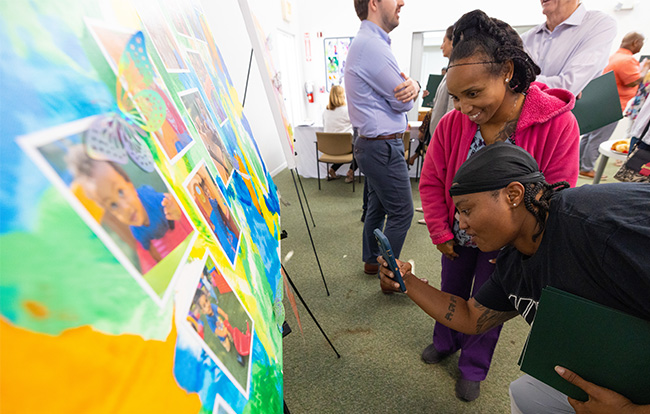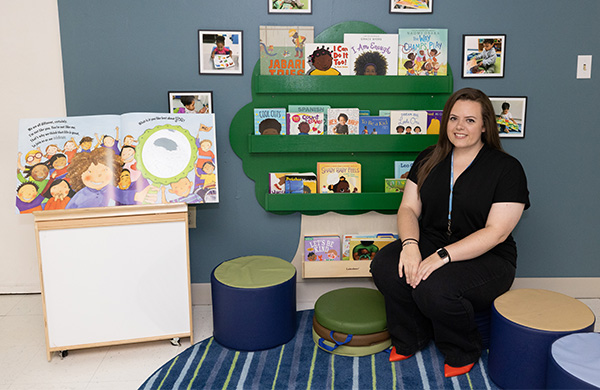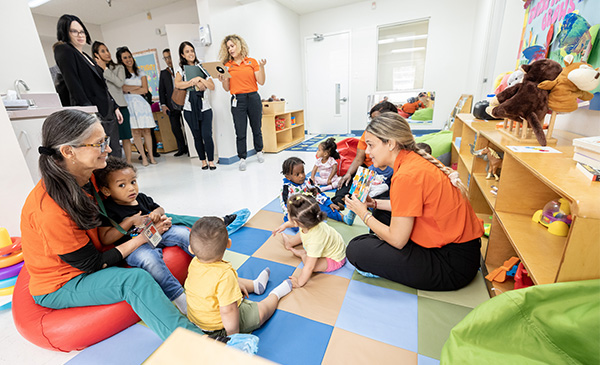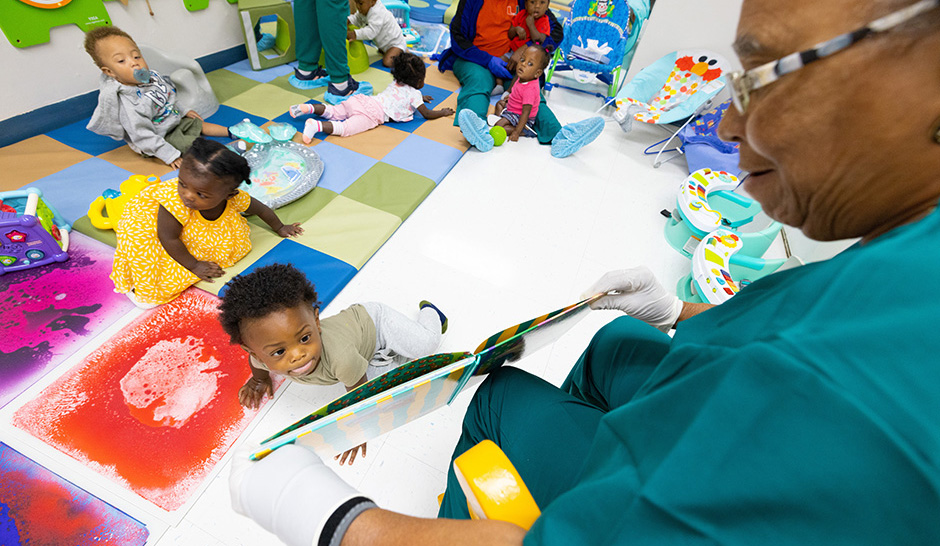Julio Borrell and Inzenga Benjamin are excited to see the artwork their 2-year-old daughter, Gabriella, created for her classroom at the University of Miami Linda Ray Intervention Center.
For the first time in a long time, Gabriella is expressing herself both vocally and creatively at home and in the classroom—all thanks to the programming and teachers at the Linda Ray Intervention Center.
“Since day one, the Linda Ray Intervention Center supported our daughter’s development,” said Benjamin. “With time she learned to express herself more at home. We are so grateful for the teachers here at the Center who have helped her growth.”
Benjamin and Borrell were not the only parents eager to see the drawings and crafts the children created for their classrooms, which were inspired by new, multicultural children’s books purchased with a sizable grant from the University of Miami Office of the President.

With parents, educators, community partners, and University affiliates present at the grand opening of the Linda Ray Intervention Center children’s art show, all eyes were on Ph.D. student Elena Fernández who secured the grant and helped create the library space with new furniture, décor, and books.
“With the money from the UM Racial Justice grant, we were able to purchase over 175 new books for the Linda Ray Intervention Center and create a multicultural library space for the children,” said Fernández, who is earning her Ph.D. in special education at the University and is a former teacher at the Linda Ray Intervention Center. “We also purchased art materials and art supplies that are representative of the diverse students who attend the Linda Ray Intervention Center, because we want them to see themselves in the art and read books with children who look like them.”

Since 1993, the Linda Ray Intervention Center has offered dedicated care and services for at-risk infants and toddlers who have developmental delays. The Center is also a research facility working with the College of Arts & Sciences Department of Psychology. University faculty collaborate with other departments within the University on cutting-edge research that focuses on developmental delays in language and cognition in children.
“As early educators we want to expose children to early literacy skills including print awareness, and print motivation. We want them to turn the pages of the book and explore pictures,” said Isabel Chica, director of the Linda Ray Intervention Center. “Early literacy also supports vocabulary and is a great way to engage children. We have all types of new books to engage the children at their age level and set them up for future academic success. Overall, the art projects and self-portraits displayed throughout the Center are unique and special to every child here. It not only provides them with a sense of belonging, but an opportunity to express themselves creatively.”

Another key component of the grant included a partnership with a local community organization. The Center collaborated with the Miami Children’s Museum, which provided the Center with cultural arts activities and musical story time experiences for the children. They were able to create unique personal portraits using black and white photography and explore different boldly colored textiles and materials, all inspired by Mexican textile artist Victoria Villasana.
Fernández gives credit to her professors in the School of Education and Human Development, Jason Mizell and Batya Elbaum, who both co-authored the proposal and the teachers at the center who diligently worked with the children.
“Elena’s project provided the Linda Ray Intervention Center with books intentionally selected to reflect the faces, lives, creativity, accomplishments, challenges, and hopes of the families and children who come to the Center every day,” said Elbaum, a developmental psychologist and education researcher. “We know that children form ideas about racial identity, gender, social roles, and other aspects of their social world quite early in life. Literature that introduces children to diverse and relatable characters—both real and imaginary—can be an important contributor to children’s positive development and sense of community.”
“Growing up, my Afro-Latin son often lamented that he never saw himself in the books that were read to him in school,” said Mizell, an assistant professor in the Department of Teaching and Learning. “The collection of books that Elena has put together provides all students with what Rudine Sims Bishop, the 'mother of multicultural children’s literature,' termed as window, mirrors, and sliding glass doors. Books that are windows provide a chance for children to see, and hopefully understand, the lives of those who are different from them and the authentic, multidimensional representations of themselves.”
Originally from Maryland, Fernández says she would like to continue her work with the Linda Ray Intervention Center after earning her Ph.D.
“I am an advocate for early intervention and the need for continued funding to support early childhood development,” said Fernández. “Looking forward, I would like to continue to address maternal and child health disparities by using my background and training to support children with multiple risk factors through research, clinical work, advocacy, and developing evidence-based interventions.”
To help support the programs at the University of Miami Linda Ray Intervention Center, click here.

